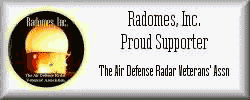Gentlemen, that reminds me.....
Radar Jargon - 2
The following information regarding U.S. "AN" designations has been copied from "Radomes, Inc":
United States radar designations during World War II
"During World War II each service used its own method to designate its electronic radar/tracking systems. For example, Army radars were classified under the initials SCR, which stood for "Signal Corps Radio" Different designations for similar systems confused manufacturers and complicated electronics procurement. In February 1943, a universal classification system was implemented for all services to follow, ending the confusion.
To indicate that an electronic system designation followed the new universal classification, the letters "AN", for Army-Navy, were placed ahead of a three-letter code. The first letter of the three-letter code denoted the type of platform hosting the electronic device, for example:
A=Aircraft
C=Air transportable (letter no longer
used starting in the 1950s)
F=Fixed permanent land-based
G=General ground
use
M=Ground mobile
S=Ship-mounted
T=Ground transportable.
The second letter indicated the type of device, for example:
P=Radar (pulsed)
Q=Sonar
R=Radio
The third letter indicated the function of the radar system device, for example:
G=Fire control
R=Receiving (passive detection)
S=Search
T=Transmitting.
Thus an AN/FPS-20 represented the twentieth design of an Army-Navy "Fixed, Radar, Search" electronic device."
(From "Searching The Skies - The Legacy Of The United States Cold War Defense Radar Program" by David Frank Winkler, June 1997),
...and some additional information:
Originally, "AN" did stand for "Army-Navy"; later, though, after the Air Force came along, it became just a 'designator' of military equipment.
The first letter designated how/where used --
"F" designated "fixed"
"T"
designated "transportable"
"M" designated "mobile"
"S" designated "ship-borne" or "sea-going" (Navy
stuff; however, I do not know if they differentiated between surface and underwater
applications)
"A" designated "airborne"
"U"
designated "special" (and I think designators were also assigned for
"vehicle-mounted" and "hand-held" equipment, too)
The second letter designated the type of equipment --
"R" designated "radio"
"P"
designated "radar" (actually, "pulsed radar")
"S"
designated "sensor" (I think)
"L" designated ? (I forget;
"launched"?)
"Y" designated "special"
The third letter designated the function of the equipment --
"A" designated "auxiliary" or "ancillary"
"S" designated "search"
"R" designated "receiver"
"T" designated "transmitter"
"Q" designated
"special-purpose"
"K" designated "digital data"
(or something like that)



